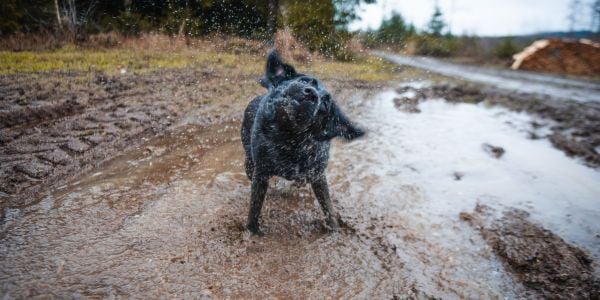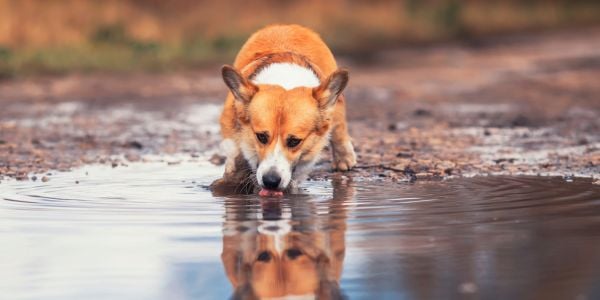 It doesn’t matter how old we may get, splashing and playing in puddles is just plain fun!
It doesn’t matter how old we may get, splashing and playing in puddles is just plain fun!
And it seems even more fun when our pup gets to join in. But that fun may not last long if those puddles are harboring health hazards for our beloved companions.
What Could Be Hiding in a Puddle?
Puddles are nature’s communal water bowl; if we are honest, it's nature's public bathroom too. Wildlife and other dogs will drink, walkthrough, and pee in puddles. Puddles, and the mud around them, are even more likely to harbor bacteria, viruses, and parasites than communal water bowls.
Here are some of the germs and diseases that can be hanging out in puddles.
Giardia
This protozoal parasite of the intestines causes Giardiasis (sometimes called “Beaver Fever”) and is a common cause of diarrhea in dogs. The degree or severity of diarrhea that Giardia infection causes in dogs varies and can range from mild to severe, depending on the subtype of Giardia the dog is infected with, their parasite load, their age, health status, and a host of other factors.
Some dogs can even be what we call “subclinical shedders,” meaning that they’re infected with the Giardia parasite and shedding the infective cysts (meaning that they can serve as a source of infection for other dogs), yet they’re not showing any signs of diarrhea.
Giardia is spread by fecal contamination, or what’s called the “fecal-oral route,” and the Giardia parasite doesn’t just survive in water; it actually thrives in it!
And while most dogs don’t go around pooping in water bowls, there is always the dog that LOVES to eat poop or mud, and plenty of them do stick their paws in and play with the water in water bowls! And if any of those mouths sampled Giardia-contaminated poop, or their paws have recently walked on Giardia-contaminated ground, mud, poop, or a puddle, that’s all it takes to create a nice “Giardia soup” for your pup to slurp down.
There is no vaccine to help protect against Giardia in dogs. Learn more about Giardia, including how it can even sicken people.
Leptospirosis
Similar to the Giardia parasite, the Leptospire bacteria (the causative organism of Leptospirosis) absolutely LOVE water! The bacteria are spread through urine from an infected animal, and it doesn’t even need to be another dog. In fact, one of the most common ways Lepto bacteria find their way into water is from infected rodents, like rats and mice. And whether you’ve seen them or not, rodents are pretty common in and around dog parks, fields, and many cities. It is also important to know that rats and mice aren’t the only wild animals to carry the Leptospire bacteria. Other animal carriers include squirrels, opossums, raccoons, skunks, foxes, and deer.
While most dogs won’t poop into the water bowl at the dog park, there are plenty of dogs that will pee in them!
Lepto is highly contagious amongst dogs, and, like Giardia, Lepto is also a zoonotic public health risk that can affect people.
There are safe and effective vaccines to help protect dogs from Lepto — talk to your vet about the vaccine for your dog. Learn more about Leptospirosis on the CDC website.
Cryptosporidiosis
Cryptosporidium is a microscopic protozoan parasite that causes cryptosporidiosis. Water can be contaminated with fecal matter from infected wild and domestic animals. The condition can cause dehydration and diarrhea in dogs. Infections are more severe and potentially life-threatening for dogs that have an immature, weakened, or compromised immune systems (e.g., puppies, seniors, or dogs on certain medications like steroids or chemotherapy).
Infection with cryptosporidium is highly concerning for Immuno-compromised individuals, and they should take extra precautions when exposed to potentially contaminated water.
Intestinal Worm Parasites
Eggs for roundworms, hookworms, and whipworms can be found in mud, and they can live there for a very long time.
Roundworms, hookworms, and whipworms don’t just cause diarrhea in dogs, but they can also cause blood and protein loss from the gut, too. The loss of blood and/or protein from the gut can lead to lethargy, weakness, pale mucus membranes, fluid accumulation within the abdomen, and a host of other problems.
Thankfully, most of the common monthly heartworm preventatives also help to protect against many of the common canine intestinal worms.
Canine Parvovirus
This highly contagious virus, Parvo for short, affects dogs' gastrointestinal tract resulting in diarrhea and vomiting. Any dog can be infected, but unvaccinated dogs and puppies less than four months of age are at the most risk.
Dogs become infected through direct contact with other dogs and contact with contaminated poop, the environment (e.g., mud around the puddles), or people (from their hands, clothes, or shoes).
The virus can survive in the environment for a long time since it is resistant to heat, cold, humidity, and drying. Dogs and people can easily transmit the virus from place to place.
Thankfully, there are safe and effective vaccines to help protect dogs from Parvo. Be sure to discuss these vaccinations with your vet and ensure that your dog is up-to-date on their shots.

Is it OK for Your Dog to Drink From Puddles?
The short answer to whether or not it’s safe or OK for your dog to drink out of a puddle is, basically, no. Just like communal water bowls can harbor all sorts of nasties, so do puddles. And to make matters worse, puddles could have additional poisoning safety risks depending on their location.
Poisoning Risk of Puddles
The risk of poisoning is especially true of puddles in driveways and on streets, as these puddles could easily contain automotive chemicals (e.g., antifreeze, gasoline, etc.) in them.
Antifreeze, in particular, is highly (HIGHLY!) toxic to animals!
Petroleum product poisoning (crude oil, motor oil, gasoline, diesel) can occur when small spills or leaks are washed down and end up in puddles in the driveway, sidewalk, or road. Toxicosis from petroleum products may affect the respiratory, gastrointestinal, or integumentary (skin) systems or the central nervous system.
Salt-based ice melters can also contaminate puddles and cause serious toxicity or digestive upset risk to dogs that drink from those puddles.
What’s the Best Way to Give Your Dog Water When Out and About?
The best way to protect your dog from puddle hazards is to carry a good, collapsible dog water bowl or hand-held dog water system on all your walks or hikes with your pup. Even if you’re not also carrying a water bottle for your dog, you can usually stop in any of the local restaurants and ask for a cup of water that you can then empty into the collapsible bowl for your dog.
Here are some of our Preventive Vet favorite “on-the-go” dog watering options:
This collapsible dog bowl by Bonza is easy to attach to your dog's leash, your belt, or bag with the included carabiner; plus you can use it for both a food and a water bowl, so it's great for travel. 100% BPA-free and dishwasher-safe! It's available in Medium, Large, and X-Large sizes.
A dog water bottle with a special lid that doubles as a bowl is a perfect all-in-one portable watering option for small to medium dogs. Simply unlock the seal and tilt the bottle to fill the lid with water. Any unused water can be tossed or tilted back into the bottle for later. It's easy to use one-handed, and the removable lid can be used on larger water bottles.
Looking for a dog water bottle that's a bit more sturdy? This Tuff Pupper PupFlask is made from stainless steel and features a silicone lid that flips down when not in use and provides a large drinking trough when open. The bottle holds 24 oz. of water, so this is perfect for larger dogs or when you're headed out for a long walk or hike.
Be safe and enjoy your time outdoors with your beloved furry companion!




